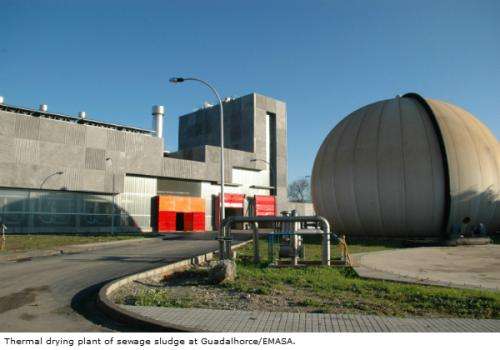More safety on thermal drying plants of sewage sludge

Researchers from the Madariaga Lab at the Universidad Politécnica de Madrid have carried out a series of trials to study the explosiveness of sludge on thermal drying plants of sewage sludge. The obtained result will help to establish benchmarks for the protection and prevention measures on site in order to reduce or even eliminate explosion risks associated to handling, transport and storage of these materials.
The amount of sewage produced has dramatically increased worldwide over the last years due to population growth and industrialization. Water treatment produces a large quantity of waste that has to be disposed of with the least environmental impact. In order to solve this issue, new wastewater treatments and reuse strategies are being developed. Today, the thermal drying of sludge is the most widely used technique since the dry sludge are considered alternative solid fuels.
The thermal process involves a moisture decrease from 90% to between 5 and 10%. This factor, along with the great dryness of the product, is responsible for the presence of large amounts of dust in these types of buildings, which causes diverse problems. Therefore, both the pollution problems and flammability properties of this kind of dust need to be addressed. The flammability properties are essential parameters for safe operations in this types of plants, and are classified into four groups: ignition sensitivity, explosion severity, sensitivity and thermal stability.
In order to identify these parameters, researchers started a research and development project at the Madariaga Lab (LOM) from the Universidad Politécnica de Madrid and funded by the Lloyd's Register Educational Trust (LRET) in which they collected 20 samples of thermally dried sewage sludge in eight Spanish plants and in different seasons of the year.
They found diverse explosivity parameters in the groups mentioned before. They also studied the variability of these parameters compared to their origin and the season of the year when the samples were collected and they observed similarities. In addition to the flammability properties, researchers also found diverse chemical and physical properties in the samples and detected significant links between composition parameters and flammability properties of thermally dried sludge.
Researchers are now able to reduce the explosion risk in normal operation through the control of these simple parameters. For example, explosion risk can be reduced by adding a percentage of inert materials to the samples. This preventive measure reduces the volatile content. Finally, the properties related to the spontaneous combustion of sewage sludge were identified. These parameters are crucial to developing safe processes and technologies for storage and transportation of these materials.
In addition to the results obtained in this project, there are some practical preventive measures than can be easily implemented and have a great value when it comes to improving safety in this types of industrial plants.
More information: Fernandez-Anez, N; Garcia-Torrent, J; Medic-Pejic, L. Flammability properties of thermally dried sewage sludge. FUEL 134: 636-643. DOI: 10.1016/j.fuel.2014.06.006. OCT 15 2014.
Provided by Universidad Politécnica de Madrid



















